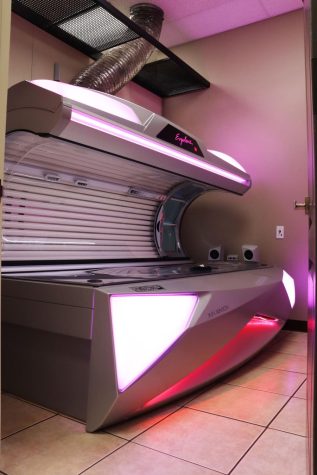Consequences of Tanning
Sunkissed skin can celebrate summer, but is it worth the health risk?
April 18, 2023
As summer settles in, more and more students focus on tanning during their free time.
Whether the tanning comes from the sun or a artificial lights, it has been proven to create unwanted consequences that many may not be aware of such as sunburn, premature aging, skin cancer, eye damage, immune system suppression and many other health issues according to the Food and Drug Administration.
Autumn Bertholdi, a staff member at Swan Dermatology in Springfield, says tanning beds can lead to several forms of cancer.
“Every time you tan in a tanning bed you increase your risk for non-melanoma skin cancer,” Bertholdi said. “Meaning, squamous cell carcinomas by 58% — that’s per visit. For basal cell squamous, that’s 24% per visit. As far as melanoma, every time you tan you increase your risk for melanoma, which is a very deadly aggressive skin cancer, about 47% risk for each use. [This can affect] everyone, anywhere from a 15-year-old to a 90-year-old.”
Sophomore Ella Holder said tanning is required to be part of a cheer team. Once she started tanning, she said it boosted her self confidence.
“I personally like tanning because I feel like it brings me a new confidence,” Holder said. “I tan in the tanning beds… at Palm Beach Tan in Nixa about once a week throughout the winter. I am aware of the long term consequences that it could give me, but considering I only tan once a week, I feel like I’m less at risk. I started fake tanning for cheer, we had to be tan for competitions and I liked it, so I kept doing it.”
There are other forms of tanning that don’t have as great of risks, if any at all. Some people use self tanning creams, which are applied like a lotion.
“If you’re a former tanner and you stop tanning, yes you reduce the risk,” Bertholdi said. “Although, once you start tanning the damage is done and it’s just important to get a routine skin check very often to make sure you’re not having any skin defects that are suspicious. If people want to tan, we usually recommend self-tanners. There’s a lot of good self tanning creams out there, or even spray tanning.”
According to the FDA, some symptoms of having skin cancer include, but are not limited to, any changes on the skin, especially in the size or color of a mole, birthmark or other dark pigmentation. Unexplained scaliness, oozing or bleeding on the skin’s surface, or a spot on the skin that suddenly feels itchy, tender or painful.
Sophomore Ava Frye chooses not to tan. Not only because of the risks that tanning beds lead to, but also because she fears the tan looking unnatural.
“I have never tanned before, but I do think I’ll tan in the future,” Frye said. “I would either spray tan or use a tanning bed. I don’t currently fake tan because I feel like everyone will make fun of me and I just don’t want to not look right. I don’t want t

he fake tan to leave lines everywhere.”






